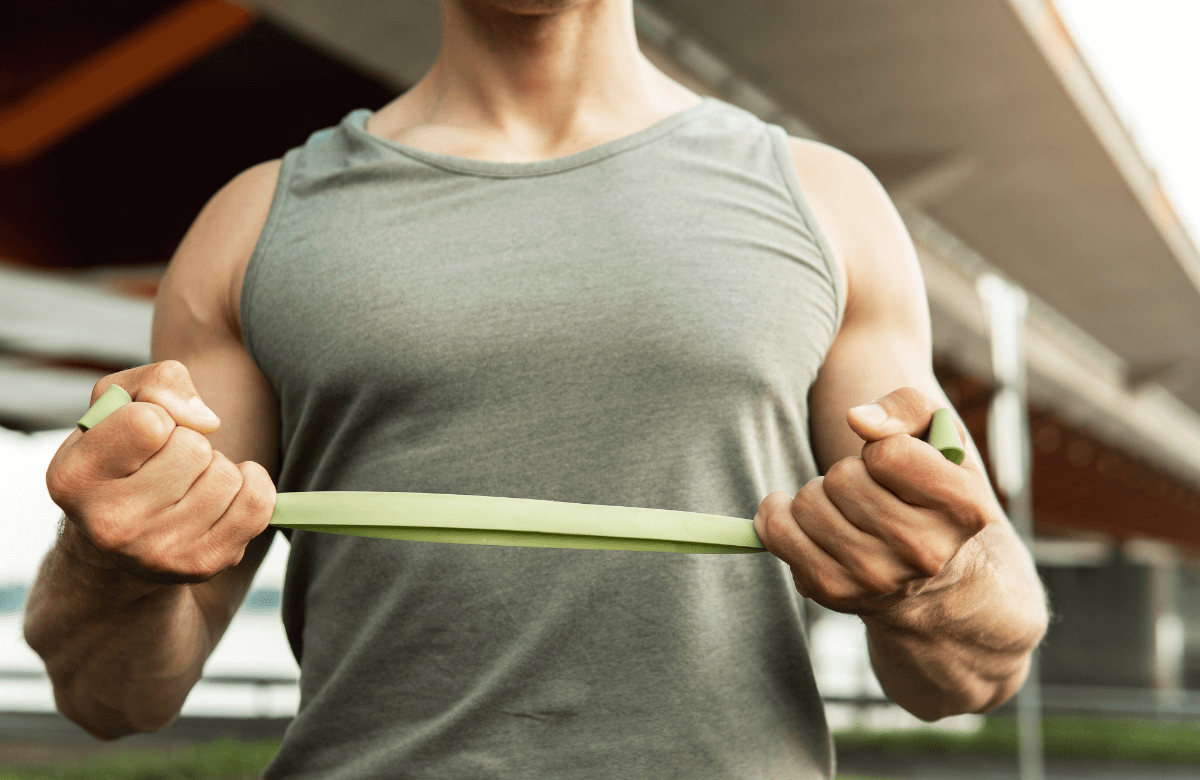Did you know you can strengthen and tone your arms without heavy weights? Resistance band arm workouts are a fantastic way to train your body and improve your physique.
Resistance bands work for every fitness level, whether you’re completely new or an elite-level athlete. They offer many benefits, like affordability, convenience, versatility, and less pressure on the joints.
Here are the best resistance band arm workouts you can do from the comfort of your living room.
Jump to:
The Anatomy of the Arms
Before you jump into resistance band arm exercises, it’s worthwhile to learn the basic anatomy of the arm muscles. Doing so will help you identify which muscles to target to improve arm strength and achieve your fitness goals.
Biceps
The biceps muscle, or the biceps brachii, is a single muscle on the front of the arm. It’s a two-headed muscle, meaning it attaches to two points of the shoulder. The heads of the upper arm muscle originate from the scapula and connect to the forearms at the same point.
The bicep has three main functions, including the following:
- Bending the elbow
- Turning the palm up
- Raising the arm forward
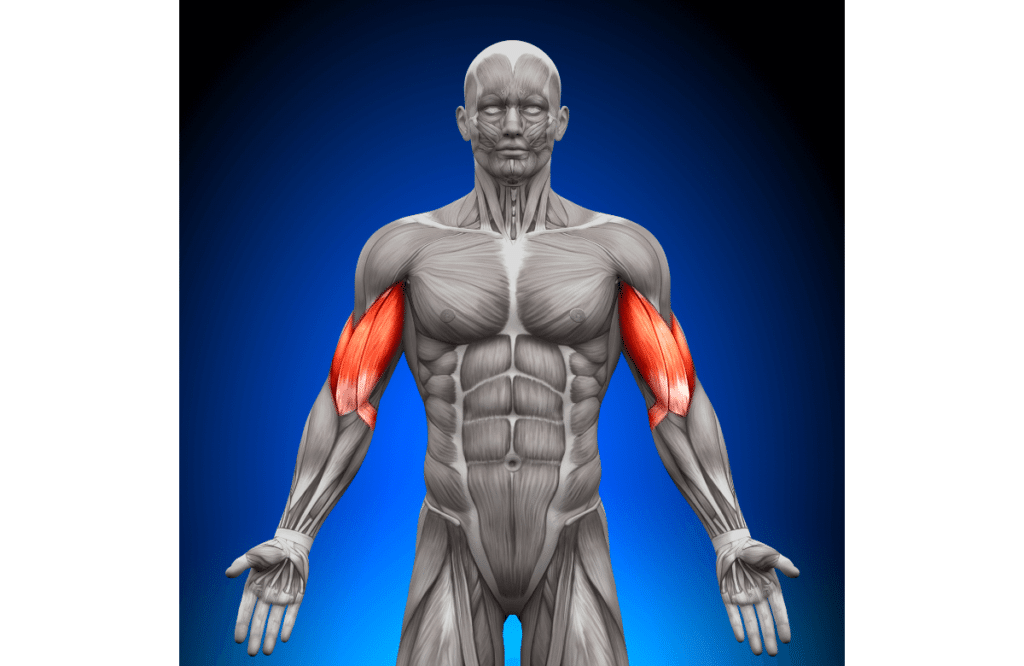
The two heads are referred to as the long head and the short head. Both parts of the muscle work together, but you can adjust your technique to engage one more than the other. Doing so will affect how the muscle grows, whether you want a wider bicep or a larger peak.
Triceps
The tricep muscles, or triceps brachii, is a large, thick muscle on the backside of the upper arm. It typically has the shape of a horseshoe and has three muscle heads—the medial head, lateral head, and long head.
The primary function of the triceps muscle is extending the elbow joint.

Most exercises target the lateral and medial head of the triceps. To target the long head of the muscle, you must use an overhead position. Targeting each portion of the muscle will help you develop fuller, thicker arms.
Shoulders
For strong shoulders, you will need to target the deltoid muscles. The deltoid is a prominent muscle and plays a critical role in movement and stability. The deltoid has three distinct portions: the front, side, and rear deltoids.
The different deltoids have unique functions, contributing to various movements of the shoulder.
- The front (anterior) deltoid is utilized during flexion and internal rotation of the arm.
- The side (lateral) deltoid assists with abduction or lifting the arm up and down.
- The rear (posterior) deltoid helps in the extension and external rotation of the arm.
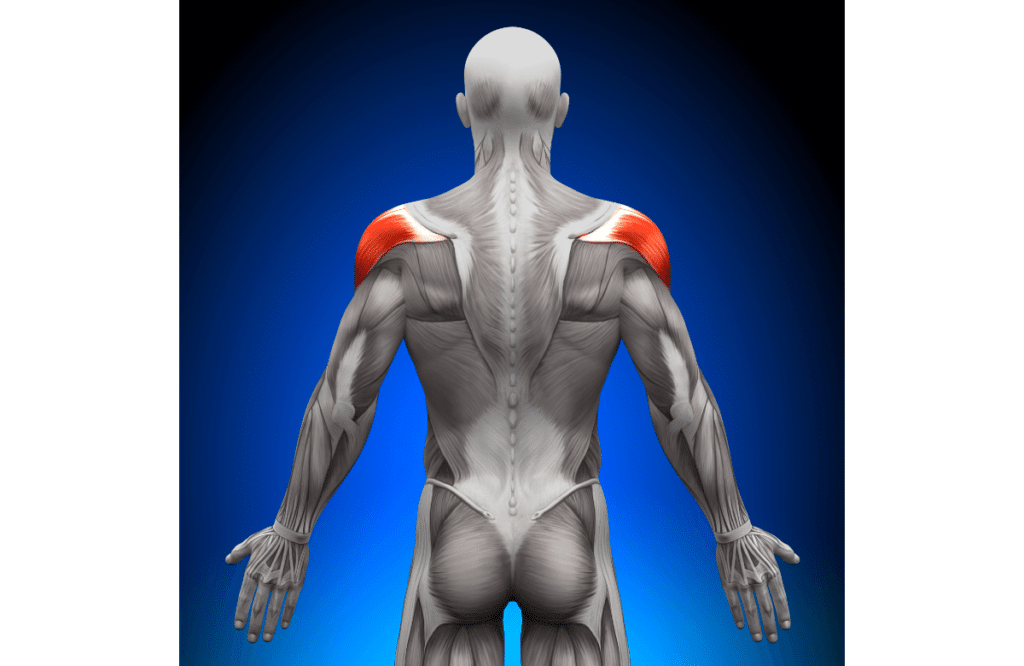
Like the other muscles, targeting each portion will provide you with a fuller and more developed arm.
The Benefits of Resistance Band Workouts
Resistance band exercises can provide a fantastic workout from the comfort of your living room. They’re convenient, affordable, and versatile, making them a staple in many strength and mobility training programs.
Cost-Effective
It’s no secret that home gym equipment can be expensive.
A set of dumbbells can easily cost a few hundred dollars, creating a higher barrier for entry. Resistance bands are a budget-friendly option, allowing almost anyone the opportunity to improve their physique.
The cost of resistance bands varies, but you can easily find complete sets for under $50. Sets include different types of resistance bands with various tension levels. This allows you to get a full workout without a significant upfront investment.
Convenient
Resistance bands are a convenient option for most individuals. The pieces of equipment are easy to store compared to more extensive options, like traditional weights or machines.
You can easily throw the resistance bands in a bag or tuck them away when not in use. When it’s time for resistance training, you can take out the bands and use them in small spaces, like a living room or bedroom.
Versatility
Exercise bands are a fantastic piece of equipment for their versatility alone. There are countless upper body exercises you can perform targeting every muscle in the arms.
Besides the arms, you can engage in a full-body workout, targeting the legs, core, and back. If you have different tension levels, you can adjust the difficulty to suit your strength training needs.
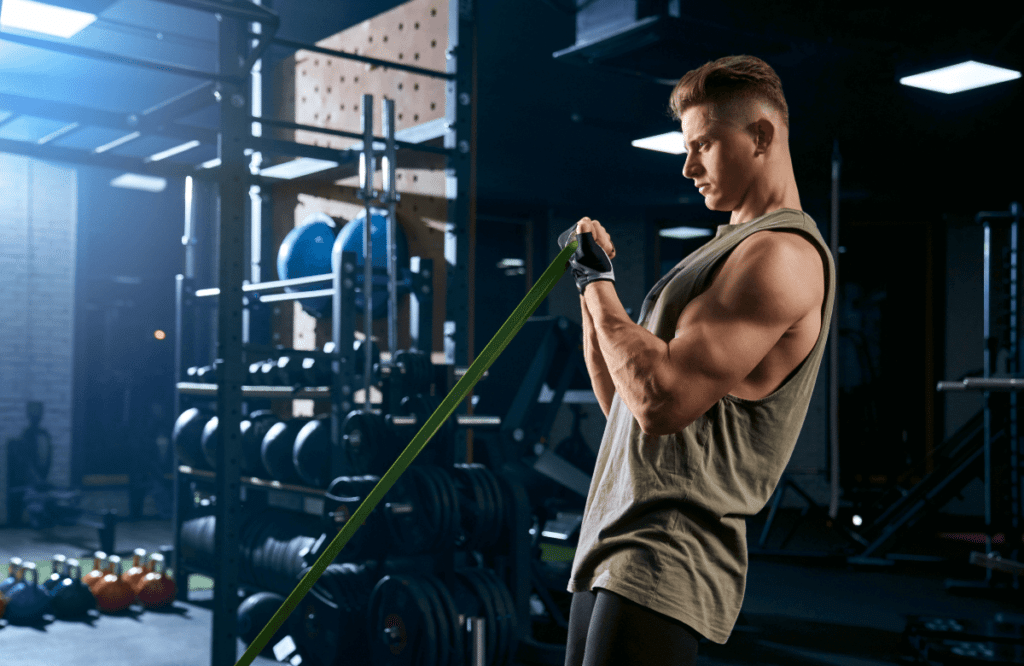
Muscle Activation
Exercise bands offer constant tension throughout the entire range of motion, which activates your muscles and enhances muscle fiber recruitment. This provides more time under tension, leading to greater muscle engagement and more effective workouts.
Increased Flexibility
Besides building strength, tension bands are often utilized for stretching and mobility training. These training methods can help improve flexibility and range of motion, making daily activities and other exercises easier.
Easy on the Joints
Resistance band arm workouts place less stress on the joints compared to heavier weights and machines. This lowers the risk of injury and makes them a fantastic solution for individuals with joint complaints or those recovering from injuries.
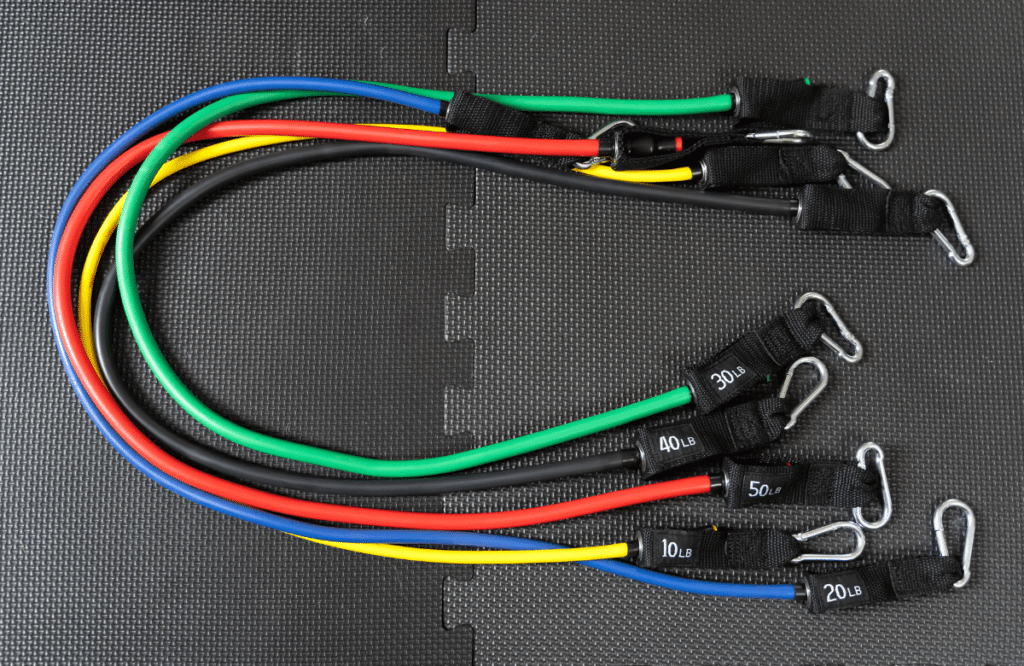
What Type of Resistance Bands to Use?
For an effective arm workout, you will need to use the correct types of resistance bands. Some movements work better with a handle or light resistance bands. Most sets will include a few options, but here are some to look out for.
Therapy Bands
Therapy bands are typically used for rehabilitation and individuals recovering from injuries. They usually have a flat surface without handles and range around four to seven feet in length.
These bands are easy on the body and can be helpful in toning, strengthening the muscles, and enhancing flexibility or mobility.
Resistance Tube Bands
Resistance tube bands, or simply tube bands, are typically longer than four feet. They include two handles on each end and can be used for the upper body, arms, and lower body.
They work well for movements like chest presses, curls, rows, and overhead presses. Tube bands are helpful for enhancing the range of motion, building muscles, and burning calories.
Mini Bands
Mini bands are also called fit loop bands. They have a flat design with a continuous loop. Mini bands are small, ranging from 10–12 inches in length.
This piece of equipment is typically used in training the lower body and enhancing flexibility and strength. Mini bands can help you stabilize your core, glutes, and hips while maintaining proper form in movements like squats and hip thrusts.
Figure 8 Bands
Figure 8 bands have a tube design in the shape of an eight. They range around 20 inches in length, with handles on either end. Figure 8 bands are primarily used in building arm muscle, with movements like shoulder presses and bicep curls.
Lateral Tube Bands
Instead of traditional handles, lateral tube bands have velcro cuffs on either end. They are usually around one foot in length and are used to train the lower body. You can attach the cuff to each ankle to train the legs, hips, and thighs.
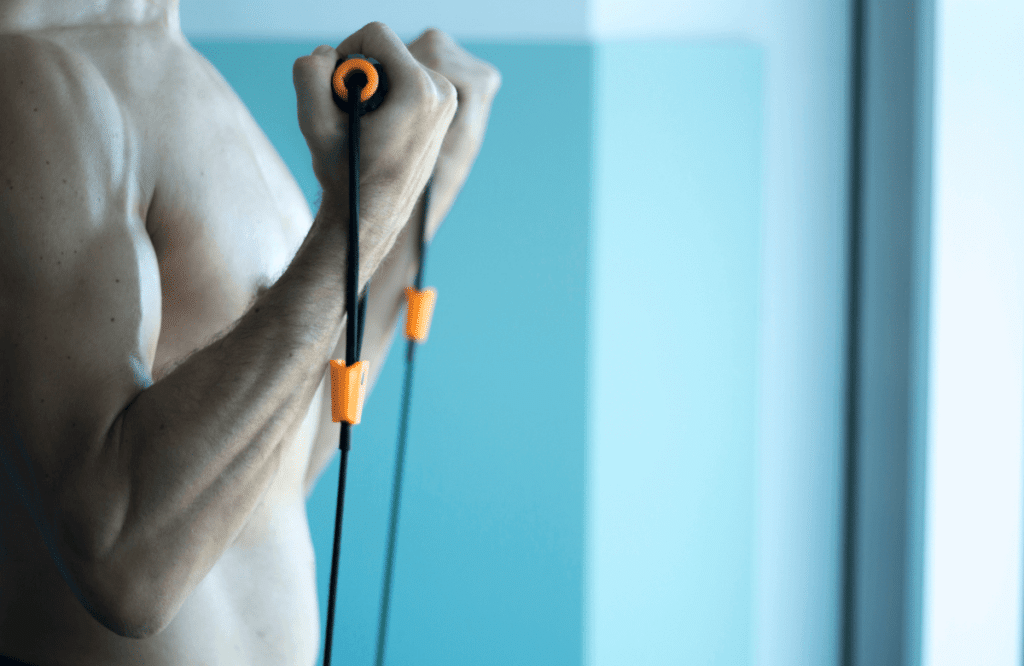
The Best Resistance Band Arm Workouts
Effective resistance band arm workouts will target all the muscles in the arms, including the biceps, triceps, and shoulders. You can use the exercises below as a complete arm training routine or add movements to your regimen as you see fit.
1. Resistance Band Bicep Curl
Resistance band bicep curls are a staple exercise for isolating the biceps and enhancing arm stability. This movement doesn’t place any extra pressure on the elbow joint compared to heavy weights.
- Position the band underneath one foot and grab the ends in both hands. Stand with a slight bend in your knees, with your palms facing toward the sky.
- Start with the bands at hip height. Bend the elbows to raise the band to shoulder height. Keep your elbows close to your ribcage throughout the entire movement.
- Carefully lower the band to finish one rep and return to the starting position. Repeat the movement for your desired rep range.
2. Tricep Kickback
The triceps kickback is a fantastic movement for engaging the triceps and enhancing their range of motion. You can adjust the difficulty by using higher tension bands or pausing during the activity.
- Place the band underneath both feet. Grab the handles with both hands.
- Start in a forward-bent stance. Keep the feet’ hip distance apart with the upper body nearly parallel to the floor.
- Pull the elastic bands behind your body until the arms are entirely extended. You can pause at full extension for additional difficulty.
- Now, lower the arms back down to complete one repetition.
3. Concentration Curl
Incorporating additional bicep variations will engage the bicep muscles further, helping you build fuller arms. The concentration curl is a simple variation requiring a chair.
- Start by sitting in a chair with your feet shoulder-width distance. Position the middle of the elastic underneath both feet.
- Now, grab the band handle with your right hand. Position the elbow on the inside of your knee with a soft bend in the torso.
- With the palms facing upward, curl the elastic toward shoulder level.
- Tighten the biceps at the top of the exercise before lowering your hand to complete one repetition. Repeat the movement for your desired rep range or 10-12 reps.
4. Overhead Triceps Extension
The overhead tricep extension is helpful for engaging the long head of the tricep, which is often neglected with traditional tricep exercises.
- Stand with the feet shoulder-width apart. Place your left foot on the elastic band.
- Grab the opposite end of the band with your left hand. Maintain the hand at shoulder height behind the back and palms facing upward.
- Stretch the resistance band toward the ceiling. Extend the arm straight overhead.
- Slowly lower the arm to the starting position and repeat.
- Repeat the movement with the opposite arm for your desired rep range.
5. Overhead Pull Apart
The overhead pull-apart will challenge your upper back and shoulder muscles. It’s a fantastic exercise for improving posture, shoulder stability, and arm strength.
- Take a stance with the feet’ shoulder-width distance. Grab a band with handles and place it directly above your head.
- Now, stretch the band apart as you lower it behind the body. Pull the band until the arms are fully extended to either side.
- Take a brief pause and return to the starting position to finish one repetition.
6. Overhead Press
The overhead press should be a staple movement in your resistance band upper body workouts. It will strengthen the shoulder muscles, improving stability and range of motion.
- Position the resistance band underneath the center of your feet, standing shoulder distance apart.
- Grip each handle and place the hands at shoulder level. Keep the palms facing straight ahead.
- Push the resistance band straight above the head until your arms are fully extended.
- Now, carefully lower your hands to the starting position to complete one repetition.
7. Forward Raise
To isolate the front deltoids, try the forward delt raise. This movement will build fuller shoulders and improve stability and balanced muscle development.
- Place the middle of the band underneath your feet with an athletic stance. Grip the handles in both hands.
- Keep your hands by your sides with the palms facing toward the thigh.
- Raise your right arm straight in front of you until you reach shoulder level.
- Carefully lower the arm back to the starting stance to finish one repetition. Complete the same movement on the opposite arm.
8. Lateral Raise
Similar to the forward raise, the banded lateral raise will strengthen the side delts. This movement can help improve shoulder stability and range of motion.
- With the resistance band underneath your right foot, take a staggered stance. The right foot should be forward, and the left foot a bit back. Maintain a slight bend in the knees.
- Grab the ends of the resistance band and keep the arms at your side.
- Raise your arms out to the sides until they are fully extended at shoulder height.
- Slowly lower the arms to the starting position to finish one repetition. Repeat the movement for your desired rep range or for 10-12 reps.
9. Bent-Over Rear Delt Fly
The bent-over rear delt fly will engage the rear delts. This will provide you with more shoulder stability, mobility, and strength.
- Stand on top of the elastic with the feet over the center portion.
- With a slight bend forward at the waist, grip both ends of the elastic at knee height and palms facing one another.
- Maintain a straight back and raise the arms out to the sides until you achieve shoulder level.
- Gently lower the arms to the starting position to complete one rep. Repeat the movement for your desired rep range.
10. Bent-Over Row
The bent-over row will engage the upper back and shoulders. It’s an excellent movement for building a more muscular upper body alongside improving posture and shoulder stability.
- Place the elastic underneath both feet. Take an athletic stance with the feet shoulder distance apart.
- Slightly bend the torso forward and grab both ends of the band right below the knee.
- Raise the straps straight up toward the ribcage. Squeeze the shoulder blades while bending the elbows.
- Now, slowly lower the band back to the starting position to finish one repetition.
11. Lat Pulldown
The resistance band lat pulldown will engage the lat muscles and arms, making it an effective workout for multiple muscle groups. You will need to hand the resistance band overhead from support.
- Begin with the feet at shoulder distance. Grab both ends of the band above your head.
- Now, maintain a straight torso and tighten the core muscles.
- Pull the elastic straight down, bringing the arms toward the sides.
- Pause when the arms are parallel to the floor before raising the band upward.
- This will be one rep. Repeat the movement for your desired rep range.
Frequently Asked Questions (FAQ)
Do Resistance Bands Tone Your Arms
Resistance bands can be a fantastic tool for strengthening and toning the arms. They can be used to improve arm strength, build muscles, and burn calories. To effectively tone your arms, you will need to adjust your diet and training protocol.
Are Resistance Bands Good for the Arms?
Yes, resistance bands are a perfect tool for the arms and upper body. They offer versatility, convenience, and different difficulty ranges. Training bands can also be used to improve mobility and flexibility without placing additional strain on the joints.
How Do You Get Rid of Flabby Arms With Resistance Bands?
Resistance bands can be used to strengthen the arms. To remove flabby arms or extra weight, you will need to burn more calories than you consume. Banded exercises are only one part of the equation, and you will need to adjust your diet accordingly.



